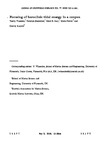Focusing of baroclinic tidal energy in a canyon
| dc.contributor.author | Vlasenko, V | |
| dc.contributor.author | Stashchuk, N | |
| dc.contributor.author | Inall, ME | |
| dc.contributor.author | Porter, M | |
| dc.contributor.author | Aleynik, D | |
| dc.date.accessioned | 2016-05-02T10:05:32Z | |
| dc.date.available | 2016-05-02T10:05:32Z | |
| dc.date.issued | 2016-05-13 | |
| dc.identifier.issn | 2169-9275 | |
| dc.identifier.issn | 2169-9291 | |
| dc.identifier.uri | http://hdl.handle.net/10026.1/4571 | |
| dc.description.abstract |
<jats:title>Abstract</jats:title><jats:p>Strong three‐dimensional focusing of internal tidal energy in the Petite Sole Canyon in the Celtic Sea is analyzed using observational data and numerical modeling. In a deep layer (500–800 m) in the center of the canyon, shear variance was elevated by an order of magnitude. Corresponding large vertical oscillations of deep isotherms and a local maximum of horizontal velocity were replicated numerically using the MITgcm. The elevated internal tidal activity in the deep part of the canyon is explained in terms of the downward propagation and focusing of multiple internal tidal beams generated at the shelf break. The near‐circular shape of the canyon head and steep bottom topography throughout the canyon (steeper than the tidal beam) create favorable conditions for the lens‐like focusing of tidal energy in the canyon's center. Observations and modeling show that the energy focusing greatly intensifies local diapycnal mixing that leads to local formation of a baroclinic eddy.</jats:p> | |
| dc.format.extent | 2824-2840 | |
| dc.language | en | |
| dc.language.iso | en | |
| dc.publisher | American Geophysical Union (AGU) | |
| dc.subject | 37 Earth Sciences | |
| dc.subject | 3708 Oceanography | |
| dc.title | Focusing of baroclinic tidal energy in a canyon | |
| dc.type | journal-article | |
| dc.type | Article | |
| plymouth.author-url | https://www.webofscience.com/api/gateway?GWVersion=2&SrcApp=PARTNER_APP&SrcAuth=LinksAMR&KeyUT=WOS:000383462300039&DestLinkType=FullRecord&DestApp=ALL_WOS&UsrCustomerID=11bb513d99f797142bcfeffcc58ea008 | |
| plymouth.issue | 4 | |
| plymouth.volume | 121 | |
| plymouth.publication-status | Published | |
| plymouth.journal | Journal of Geophysical Research: Oceans | |
| dc.identifier.doi | 10.1002/2015JC011314 | |
| plymouth.organisational-group | /Plymouth | |
| plymouth.organisational-group | /Plymouth/Faculty of Science and Engineering | |
| plymouth.organisational-group | /Plymouth/Faculty of Science and Engineering/School of Biological and Marine Sciences | |
| plymouth.organisational-group | /Plymouth/REF 2021 Researchers by UoA | |
| plymouth.organisational-group | /Plymouth/REF 2021 Researchers by UoA/UoA07 Earth Systems and Environmental Sciences | |
| plymouth.organisational-group | /Plymouth/Research Groups | |
| plymouth.organisational-group | /Plymouth/Research Groups/Marine Institute | |
| plymouth.organisational-group | /Plymouth/Users by role | |
| plymouth.organisational-group | /Plymouth/Users by role/Academics | |
| dcterms.dateAccepted | 2016-04-01 | |
| dc.rights.embargodate | 2016-11-13 | |
| dc.identifier.eissn | 2169-9291 | |
| dc.rights.embargoperiod | 6 months | |
| rioxxterms.versionofrecord | 10.1002/2015JC011314 | |
| rioxxterms.licenseref.uri | http://www.rioxx.net/licenses/under-embargo-all-rights-reserved | |
| rioxxterms.licenseref.startdate | 2016-05-13 | |
| rioxxterms.type | Journal Article/Review |


